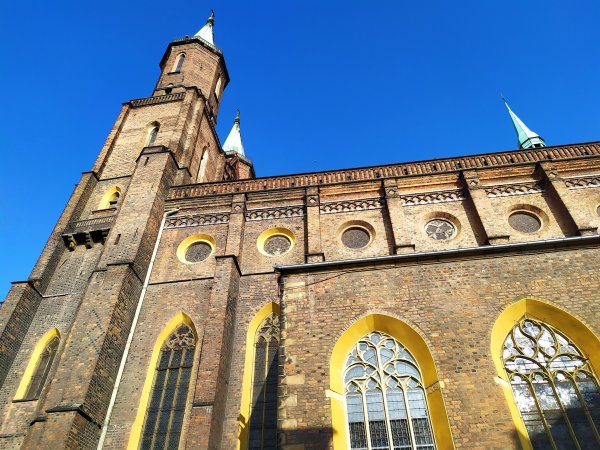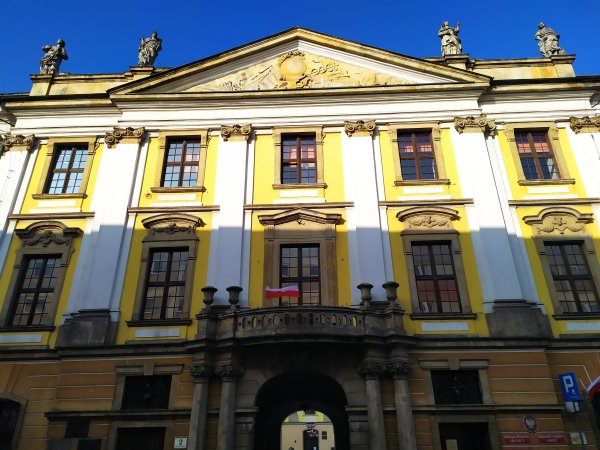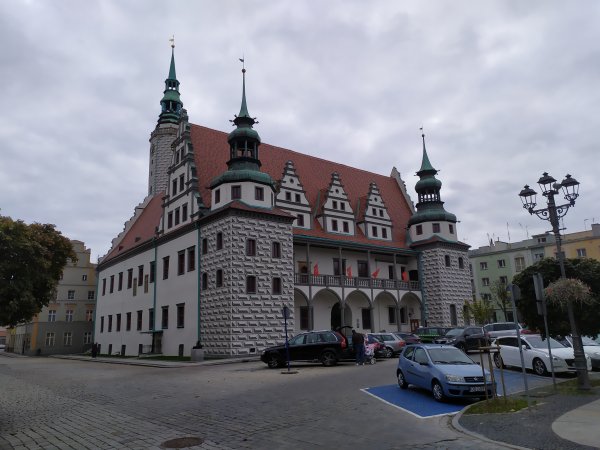
The cooling temperature of the winter, the deepening crisis of the covid-pandemic and my university duties made it extremely difficult to continue my adventures and visit more of Poland. However, as I have pointed out in many of my articles before, a devoted traveler should always use their creativity and consider their possibilities, whatever the conditions offer. If someone is open enough and learns how to estimate even the simplest and smallest places, new, entire universes can reveal themselves that one would not see otherwise.


Remembering this concept, I had decided to check what else I could find in the Silesian region where I was staying; particularly in Lower- and Opolian Silesia. Well, as a result, even some unexpected and pleasant surprises helped me with satisfying my curiosity which I am going to tell you about later, in another article.


Now, in turn, I would like to invite you to explore a real gem of Lower-Silesia (Dolny Śląsk), which is maybe a little bit unknown and hidden for foreigners and remains in the shadow of Wrocław: it is the city of Legnica, an important cultural and clerical centre of the region, which is not so far away from the voivodeship’s capital.


The city used to be a significant location for the dukes of Silesia for many centuries besides Wrocław, especially when the Duchy of Silesia was quasi-independent under the rule of the Piast dukes, but for some period it was also a part of Bohemia.
Regardless the various lords of the city in history though, it had always maintained its own, unique, local identity, as images of the proud and famous Silesian Eagle represent it all around the region, and Legnica is not an exception from that either.


The Czechs called the two key places of the region as Vratislav (Wrocław) and Lehnice (Legnica), while later, during the Prussian and German control it was referred to as Liegnitz.
After the Second World War, when the territories of Poland were changed, Legnica became a Polish city again, and during the socialist decades of the 20th century people used to call it ‘Little Moscow’ (Mała Moskwa) due to the fact that many Soviet troops were stationed in the area.



Whoever owned the place though, one thing has never changed. The nobility, honor and aristocratic elegance of Legnica can still be recognized in the air, so it is no wonder that even the local brewery (browar) uses the adjective książęcy (‘ducal’), which recalls the former rulers of the place.


My overall impression is that the city collects the architectural features of many other places I have seen before, particularly in Silesia, which means that there are medieval, classicist, baroque, art nouveau, eclectic and industrial elements equally, while the most frequent colors are red, brown, black similar dark shades.


I had already noticed the dominance of such colors in Katowice and especially in Wrocław, that really resembled this city; however, Legnica has utterly perfectionized the rule of these components, which gave a very raw and sharp, but also a very characteristic atmosphere to the place.
Here ever single brick, window or roof tile served a certain role in the story, while the dozens of small streets formed all together quite a large old town, which had buildings in many different historical styles, just like everything in Legnica.



Of course, it is inevitable for a dukal family to have its own residence (zamek) everywhere, and the Piast castle is a true symbol of the city centre, although it is slightly different from the rest of the monuments in the place. The walls and the shape of the fortress standing on a small hill reminded me of Wawel castle in Kraków, but one of its iconic cover towers really looked like the famous Piast tower in Opole.


There is another small, lonely tower close to the entrance of the castle yard and the main road: this is Brama Głogowska, the remains of one of the former gates of the city, that welcomes the castle’s visitors from one side, while the enormous church building of Saint Mary with its long, skyscraping towers and gothic structure borders the old town from the other direction.


Let’s walk by the church towards the old market square (rynek), that was my personal favourite with its friendly and cozy curves. On our way, we will definitely find the Neptune Fontain (Fontanna Neptuna), a mesmerizing and genius statue of the ancient Roman god of sea, which is really a remarkable piece of art.


Such fontaines and monument can be noticed all around the city: another one is Wodna Panna (Watery Miss), a mythical creature that is here pictured as a mermaid, or the Boy with Swan (Chłopiec z Łabędziem), which is one of the many copies of the original piece from Chorzów, which are erected in plenty of different cities, mostly in Poland.


The Neptune fontaine was built by the side of the cathedral named after Apostles Saint Peter and Paul, which I could not visit, just as it was the case with some other churches; yet the catholic monumentality and the typical, sacred environment the place created was vivid and present even from the outside.
Not so far away from the cathedral another beautiful sight stands: namely the Old Town Hall (Stary Ratusz), which has a pure white color with smooth, classical, round shapes, charming stairs and a humble, but respectable tower in the middle.
Nowy Ratusz, the New Town Hall is not less gorgeous either, and while its facade makes us feel like in the Rynek of Wrocław, its ornaments throw us back to the times of ancient tradition and medieval spirit.


If you continue your walk by this very centre, you will also meet the Herring Houses (Kamienice Śledziowe) that were most probably named due to the fact that fish sellers used to have their stalls right under these buildings. Besides, Legnica has a wonderful theater and many further chapels, offices or town houses which are must-see.


One thing which is certainly recommended is the Mausoleum of Silesian Piast Dukes (Mauzoleum Piastów Śląskich), which can be approached if one enters the church of Saint John the Baptist.


Although the main nave of the building, its paintings and decorations are fascinating on their own, the frescos and rich ornaments of this perfectly round mausoleum indeed have something deeply celestial within. Finally, after this long and various historical experience it might be a suitable end for the trip to visit the city park and the peaceful shores of its lakes.


The patterns and vibes of Legnica can be also noticed in a kind and hospitable town of Opolian Silesia, Brzeg, where the list of genuine pieces of architecture begins right at the railway station. The city is mostly famous for its huge and incredibly fantastic castle, which rather looks like a Renaissance palace, since the visitor who enters the yard can see many round corridors and loggias.



Even if someone does not have the chance to get in the castle museum, the vine leaves and tendrils growing in red, green and yellow on the walls and covering them; the cannons, the stones and the general outlook of the building are all worth observing in person.



The castle is relatively close to river Oder (Odra), and if you cross the bridge, you can not just admire its foams and the distance, but you will bump into the interesting reconstruction with a garden, which tries to show how Villa Moll (Ruiny Willa Mollów) looked before it turned into ruins.
However, that is not all about the town: one should mention the gigantic walls of the Ratusz, the local Town Hall, which is much more decorated and fabulous than many others of this genre and is equally worthy with the castle to be seen.



Apart from that, the third miracle of the city is the Saint Nicholas’ Church (Kościół św. Mikołaja), that has thick, heavy walls of thousands of bricks and rather reminds us of a Romanesque style, although the colorful, tall, bright and shining windows and the spiritual space inside the hall suggest that this case is something different, and might have something to do with the decorative Gothic style too.



If we leave the building, the statue of Pope Saint John Paul II, the probably most popular priest of the modern history of Poland greets the tourists and pilgrims, and then he also invites them to go to the Holy Cross, church of the Jesuits, close to the castle itself.


Last, but not least, we should keep the unique and intact nature of the city park in mind, whose endless green forests include a brook and some small ponds with ducks, which are extremely amazing in every period of the year, but mainly in the autumn.
I would like to add another town, Oława to this time’s episode, which is close to Brzeg, and also has a great city park next to the railway station.


The name of the town is also special, since it most probably refers to the Walloons (mainly weavers) who settled here, which would mean that the name has a similar root with the Hungarian and Polish words for Italian (olasz, włoski) and the old Hungarian word for Rumanian (oláh), who are also Romance people.
Although the coat-of-arms of the place, which is a sort of Walloonian rooster, confirms this theory, there is also a tradition about a Czech knight, Olav and his family owning the region.


Oława does not provide a lot to see, and one morning or afternoon is completely enough to visit everything, but the dukal castle with the main church (here Saint Peter and Paul as well), the market square with the town hall (a bit similar to the Fire Tower of Sopron in Hungary) and some small monuments remembering the world wars can all draw our attention.

The river of the town, which has the same name, is also very interesting; although it runs pretty close to the giant waves of Oder, it eventually prefers to wait until Wrocław, and, as a matter of fact, it finishes its adventures in this other and larger river not so far from Most Grunwaldzki (Grunwaldzki Bridge): the bridge where I also have my university campus nearby.
